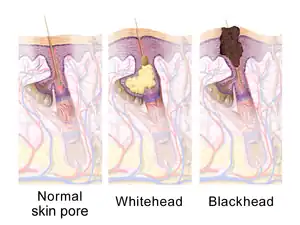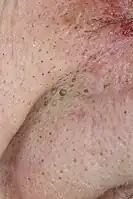Comedo
| Comedo | |
|---|---|
| Other names: Plural: comedones[1] | |
 | |
| Illustration comparing a normal skin pore with a whitehead and a blackhead | |
| Specialty | Dermatology |
A comedo is a clogged hair follicle (pore) in the skin.[2][3] Keratin (skin debris) combines with oil to block the follicle.[4] A comedo can be open (blackhead) or closed by skin (whitehead) and occur with or without acne.[4] The word comedo comes from the Latin comedere, meaning 'to eat up', and was historically used to describe parasitic worms; in modern medical terminology, it is used to suggest the worm-like appearance of the expressed material.[1]
The chronic inflammatory condition that usually includes both comedones, inflamed papules and pustules (pimples), is called acne.[4][5] Infection causes inflammation and the development of pus.[3] Whether a skin condition classifies as acne depends on the amount of comedones and infection.[5] Comedones should not be confused with sebaceous filaments.
Comedo-type ductal carcinoma in situ (DCIS) is not related to the skin conditions discussed here. DCIS is a non-invasive form of breast cancer, but comedo-type DCIS may be more aggressive and so may be more likely to become invasive.[6]
Signs and symptoms
A Comedo is small and flesh-colored with a rough texture. Furthermore are located at skin pore openings[7]
.jpg.webp) Plugged follicles forming comedones
Plugged follicles forming comedones.jpg.webp) Open comodones
Open comodones Multiple closed comedones at the nasolabial fold and the alar of the nose
Multiple closed comedones at the nasolabial fold and the alar of the nose
Causes
Oil production in the sebaceous glands increases during puberty, causing comedones and acne to be common in adolescents.[4][5] Acne is also found premenstrually and in women with polycystic ovarian syndrome.[4] Smoking may worsen acne.[4]
Oxidation rather than poor hygiene or dirt causes blackheads to be black.[3] Washing or scrubbing the skin too much could make it worse, by irritating the skin.[3] Touching and picking at comedones might cause irritation and spread infection.[3] It is not clear what effect shaving has on the development of comedones or acne.[3]
Some, but not all, skin products might increase comedones by blocking pores,[3] and greasy hair products (like pomades) can worsen acne.[4] Skin products that claim to not clog pores may be labeled noncomedogenic or non-acnegenic.[8] Make-up and skin products that are oil-free and water-based may be less likely to cause acne.[8] It is not known whether dietary factors or sun exposure make comedones better, worse or have no effect.[4]
A hair that does not emerge normally, an ingrown hair, can also block the pore and cause a bulge or lead to infection (causing inflammation and pus).[5]
Genes may play a role in the chances of developing acne.[4] Comedones may be more common in some ethnic groups.[4][9] People of Latino and recent African descent may experience more inflammation in comedones, more comedonal acne, and earlier onset of inflammation.[4][9]
Pathophysiology
Comedones are associated with the pilosebaceous unit, which includes a hair follicle and sebaceous gland. These units are mostly on the face, neck, upper chest, shoulders and back.[4] Excess keratin combined with sebum can plug the opening of the follicle.[4][10] This small plug is called a microcomedo.[10] Androgens increase sebum (oil) production.[4] If sebum continues to build up behind the plug, it can enlarge and form a visible comedo.[10]
A comedone may be open to the air ("blackhead") or closed by skin ("whitehead").[3] Being open to the air causes oxidation, which turns it black.[3] Cutibacterium acnes is the suspected infectious agent in acne.[4] It can proliferate in sebum and cause inflamed pustules (pimples) characteristic of acne.[4] Nodules are inflamed, painful deep bumps under the skin.[4]
Comedones that are 1 mm or larger are called macrocomedones.[11] They are closed comedones and are more frequent on the face than neck.[12]
Solar comedones (sometimes called senile comedones) are related to many years of exposure to the sun, usually on the cheeks, not to acne-related pathophysiology.[13]
Management
Using non-oily cleansers and mild soap may not cause as much irritation to the skin as regular soap.[14][15] Blackheads can be removed across an area with commercially available pore-cleansing strips (which can still damage the skin by leaving the pores wide open and ripping excess skin) or the more aggressive cyanoacrylate method used by dermatologists.[16]
Squeezing blackheads and whiteheads can remove them, but it can also damage the skin.[3] Doing so increases the risk of causing or transmitting infection and scarring, as well as potentially pushing any infection deeper into the skin.[3] Comedo extractors are used with careful hygiene in beauty salons and by dermatologists, usually after using steam or warm water.[3]
Complementary medicine options for acne in general have not been shown to be effective in trials.[4] These include aloe vera, pyridoxine (vitamin B6), fruit-derived acids, kampo (Japanese herbal medicine), ayurvedic herbal treatments and acupuncture.[4]
Some acne treatments target infection specifically, but there are treatments that are aimed at the formation of comedones as well.[17] Others remove the dead layers of the skin and may help clear blocked pores.[3][4][5]
Dermatologists can often extract open comedones with minimal skin trauma, but closed comedones are more difficult.[4] Laser treatment for acne might reduce comedones,[18] but dermabrasion and laser therapy have also been known to cause scarring.[11]
Macrocomedones (1 mm or larger) can be removed by a dermatologist using surgical instruments or cauterized with a device that uses light.[11][12] The acne drug isotretinoin can cause severe flare-ups of macrocomedones, so dermatologists recommend removal before starting the drug and during treatment.[11][12]
Some research suggests that the common acne medications retinoids and azelaic acid are beneficial and do not cause increased pigmentation of the skin.[19] If using a retinoid, sunscreen is recommended.
Rare conditions
Favre–Racouchot syndrome occurs in sun-damaged skin and includes open and closed comedones.[20]
Nevus comedonicus or comedo nevus is a benign hamartoma (birthmark) of the pilosebaceous unit around the oil-producing gland in the skin.[21] It has widened open hair follicles with dark keratin plugs that resemble comedones, but they are not actually comedones.[21][22]
Dowling-Degos disease is a genetic pigment disorder that includes comedo-like lesions and scars.[23][24]
Familial dyskeratotic comedones is a rare autosomal dominant genetic condition, with keratotic (tough) papules and comedo-like lesions.[25][26]
See also
References
- 1 2 "Comedo". Oxford Dictionary. Oxford University Press. Archived from the original on 21 December 2013. Retrieved 16 June 2013.
- ↑ "Comedonal acne". dermnetnz.org. Archived from the original on 6 February 2022. Retrieved 1 May 2023.
- 1 2 3 4 5 6 7 8 9 10 11 12 13 Informed Health Online. "Acne". Fact sheet. Institute for Quality and Efficiency in Health Care (IQWiG). Archived from the original on 16 June 2013. Retrieved 9 June 2013.
- 1 2 3 4 5 6 7 8 9 10 11 12 13 14 15 16 17 18 19 20 21 Williams, HC; Dellavalle, RP; Garner, S (Jan 28, 2012). "Acne vulgaris". Lancet. 379 (9813): 361–72. doi:10.1016/S0140-6736(11)60321-8. PMID 21880356. S2CID 205962004.
- 1 2 3 4 5 Purdy, Sarah; De Berker, David (2011). "Acne vulgaris". BMJ Clinical Evidence. 2011: 1714. PMC 3275168. PMID 21477388.
- ↑ National Cancer Institute. "Breast cancer treatment". Physician Desk Query. National Cancer Institute. Archived from the original on 23 May 2013. Retrieved 13 June 2013.
- ↑ "Comedones: MedlinePlus Medical Encyclopedia". medlineplus.gov. Archived from the original on 21 April 2021. Retrieved 21 May 2021.
- 1 2 British Association of Dermatologists. "Acne". Patient information leaflet. British Association of Dermatologists. Archived from the original on 2013-10-04. Retrieved 12 June 2013.
- 1 2 Davis, EC; Callender, VD (April 2010). "A review of acne in ethnic skin: pathogenesis, clinical manifestations, and management strategies". The Journal of Clinical and Aesthetic Dermatology. 3 (4): 24–38. PMC 2921746. PMID 20725545.
- 1 2 3 Burkhart, CG; Burkhart, CN (October 2007). "Expanding the microcomedone theory and acne therapeutics: Propionibacterium acnes biofilm produces biological glue that holds corneocytes together to form plug". Journal of the American Academy of Dermatology. 57 (4): 722–4. doi:10.1016/j.jaad.2007.05.013. PMID 17870436.
- 1 2 3 4 Wise, EM; Graber, EM (November 2011). "Clinical pearl: comedone extraction for persistent macrocomedones while on isotretinoin therapy". The Journal of Clinical and Aesthetic Dermatology. 4 (11): 20–1. PMC 3225139. PMID 22132254.
- 1 2 3 Primary Care Dermatology Society. "Acne: macrocomedones". Clinical Guidance. Primary Care Dermatology Society. Archived from the original on 10 March 2014. Retrieved 12 June 2013.
- ↑ DermNetNZ. "Solar comedones". New Zealand Dermatological Society. Archived from the original on 29 May 2013. Retrieved 16 June 2013.
- ↑ Poli, F (Apr 15, 2002). "[Cosmetic treatments and acne]". La Revue du Praticien. 52 (8): 859–62. PMID 12053795.
- ↑ Korting, HC; Ponce-Pöschl, E; Klövekorn, W; Schmötzer, G; Arens-Corell, M; Braun-Falco, O (Mar–Apr 1995). "The influence of the regular use of a soap or an acidic syndet bar on pre-acne". Infection. 23 (2): 89–93. doi:10.1007/bf01833872. PMID 7622270. S2CID 39430391.
- ↑ Pagnoni, A; Kligman, AM; Stoudemayer, T (1999). "Extraction of follicular horny impactions the face by polymers. Efficacy and safety of a cosmetic pore-cleansing strip (Bioré)". Journal of Dermatological Treatment. 10 (1): 47–52. doi:10.3109/09546639909055910.
- ↑ Gollnick, HP; Krautheim, A (2003). "Topical treatment in acne: current status and future aspects". Dermatology. 206 (1): 29–36. doi:10.1159/000067820. PMID 12566803. S2CID 11179291.
- ↑ Orringer, JS; Kang, S; Hamilton, T; Schumacher, W; Cho, S; Hammerberg, C; Fisher, GJ; Karimipour, DJ; Johnson, TM; Voorhees, JJ (Jun 16, 2004). "Treatment of acne vulgaris with a pulsed dye laser: a randomized controlled trial". JAMA: The Journal of the American Medical Association. 291 (23): 2834–9. doi:10.1001/jama.291.23.2834. PMID 15199033.
- ↑ Woolery-Lloyd, HC; Keri, J; Doig, S (Apr 1, 2013). "Retinoids and azelaic Acid to treat acne and hyperpigmentation in skin of color". Journal of Drugs in Dermatology. 12 (4): 434–7. PMID 23652891. Archived from the original on January 21, 2021. Retrieved May 5, 2021.

- ↑ Rapini, Ronald P.; Bolognia, Jean L.; Jorizzo, Joseph L. (2007). Dermatology: 2-Volume Set. St. Louis: Mosby. p. 1847. ISBN 978-1-4160-2999-1.
- 1 2 Zarkik, S; Bouhllab, J; Methqal, A; Afifi, Y; Senouci, K; Hassam, B (Jul 15, 2012). "Keratoacanthoma arising in nevus comedonicus". Dermatology Online Journal. 18 (7): 4. PMID 22863626.
- ↑ DermNetNZ. "Comedo Naevus". New Zealand Dermatological Society. Archived from the original on 21 May 2013. Retrieved 16 June 2013.
- ↑ Bhagwat, PV; Tophakhane, RS; Shashikumar, BM; Noronha, TM; Naidu, V (Jul–Aug 2009). "Three cases of Dowling Degos disease in two families" (PDF). Indian Journal of Dermatology, Venereology and Leprology. 75 (4): 398–400. doi:10.4103/0378-6323.53139. PMID 19584468. Archived (PDF) from the original on 2018-07-22. Retrieved 2021-05-05.
- ↑ Khaddar, RK; Mahjoub, WK; Zaraa, I; Sassi, MB; Osman, AB; Debbiche, AC; Mokni, M (January 2012). "[Extensive Dowling-Degos disease following long term PUVA therapy]". Annales de Dermatologie et de Vénéréologie. 139 (1): 54–7. doi:10.1016/j.annder.2011.10.403. PMID 22225744.
- ↑ Hallermann, C; Bertsch, HP (Jul–Aug 2004). "Two sisters with familial dyskeratotic comedones". European Journal of Dermatology. 14 (4): 214–5. PMID 15319152.
- ↑ OMIM. "Comedones, familial dyskeratotic". OMIM database. OMIM. Archived from the original on 15 June 2013. Retrieved 13 June 2013.
External links
| Classification |
|---|
- Rines, George Edwin, ed. (1920). . Encyclopedia Americana.
- What causes blackheads, Treatment and Prevention Archived 2020-01-27 at the Wayback Machine